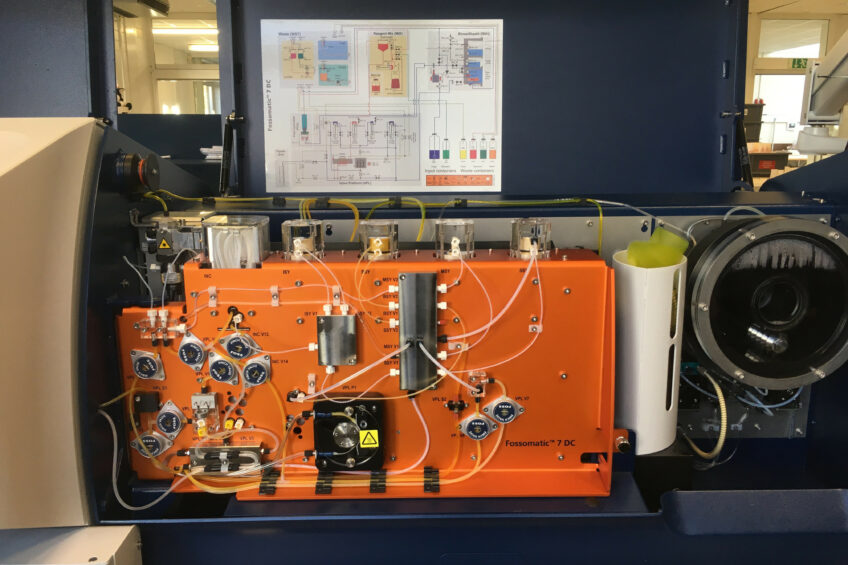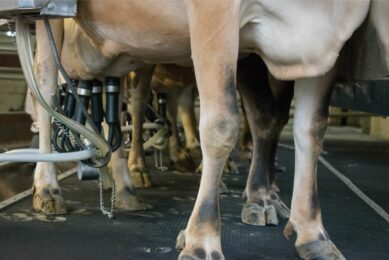Udder health: The type of somatic cells is key

A German milk lab uses advanced milk-testing technology to help farmers make better herd level decisions.
For decades now, milk-testing laboratories have been using somatic cell count as an indicator of mastitis. And while somatic cell count is still the best test for mastitis screening, a more refined screening method could help dairy farmers further improve herd health. Under the direction of Peter Höckels, German milk laboratory Landeskontrollverband Nordrhein Westfalen aims to do just that by using advanced milk-testing technology. Fossomatic 7 DC, said Höckels, could be a game changer for dairy farmers around the world.

Indexing udder health data
When infection is present in the udder, the body sends high numbers of somatic cells to the injured site. Not all cells are created equal, though, and different parts of cells give important information on the status of mastitis and inflammation. Oftentimes that information isn’t available until after it’s too late to do anything about it. Mr Höckels and the milk laboratory are part of a collaborative project called ZellDiX that aims to improve milk control by assessing and indexing udder health data using cell differentiation technology. It is their hope that the information will lead to a reduction in antimicrobial use, and improve productivity and udder health. “Until today we are only able to count the total somatic cells and there was no possibility to look into these somatic cells and to find out which kinds of cells are in the samples. Is the inflammation acute or chronic for example? We think it’s very important to have this information to give answers to the farmers for useful treatment of cows,” Mr Höckels explained.
Macrophages, granulocytes and lymphocytes counted
Somatic cells are divided into 3 components:
- the lymphocytes,
- the macrophages and
- the branulocytes or polymorphonuclear neutrophils (PMN).
All 3 components play a vital role in the inflammatory response inside the mammary gland, explained Mr Höckels. The proportion of the 3 different cells is dependent on the status of the inflammation. In a healthy udder, somatic cells are low, as are macrophages. If there is inflammation, the number of somatic cells increases; the number of granulocytes (PMNs) will also increase. Rather than just providing an overall cell count.
The Fossomatic 7 DC gives 2 new results:
- the number of the macrophages and
- number of granulocytes and lymphocytes.
FOSS works with a special index, explained Mr Höckels. “They call it the DSCC. That is the percentage of granulocytes and lymphocytes on the total amount of cells,” he said.

More chronic, more granulytes
Knowing the exact numbers of the different types of cells present could determine how producers respond to elevated numbers. We know, for instance, that as mastitis becomes more and more chronic, the number of granulocytes decreases, explained Mr Höckels. “We also find again more macrophages. This information is not really new, but what is new is that we can analyse them today. We don’t know exactly, but maybe if there is inflammation, maybe the number of granulocytes increases earlier than the somatic cells. We don’t know it exactly but we are still working on this project.”
Farmer’s decision based on type and amount of cells
The project works with another index as well, which Mr Höckels and his team calls ZDI – or cell differentiation index. The index shows the percentage of macrophages present within the entire somatic cell count. Höckels provides an example that illustrates just how important access to this type of data could be for the farmer. Imagine a farmer has 2 cows, he said, Bertha and Else. Both have 600,000 SCC, but the cell differentiation of each cow is dissimilar. Bertha has 420,000 PMNs, 120,000 macrophages and 60,000 lymphocytes. Else, on the other hand, has 330,000 PMNs, 210,000 macrophages and 60,000 lymphocytes. “That means that Bertha has very acute inflammation,” Mr Höckels said. “The other cow, which has the same amount of somatic cells, has only 55% of granulocytes, but 35 per cent macrophages. So Else, it would seem, has a more chronic event. The question, then, is what should the farmer do next? Does it make sense to treat her with antibiotics?” Mr Höckels asked. “Or maybe the results are worse than this. Maybe the farmer will decide to send the animal to slaughter.”

Working on interpretation of the results
Mr Höckels is clearly excited about the technology’s potential. “Since just a few weeks ago, we are able to get data from milk samples out of routine analyses in a very huge amount,” he said. “Until now, we had only a few samples from some farms and it was not a really great amount of data. Now we are able to produce this great amount of data and to verify the results.” Today, Mr Höckels and his team at the lab are working to verify the new information, trying to find a way to make it useful on-farm. “We have to work on an interpretation for the farmers to find a good way to give the results to the farmers,” he said. “We think it makes no sense to give more data and more figures to the farmers. We have to develop a good working interpretation of these results. Maybe with a traffic light – red, yellow, green – something like this. It’s very new information, and we think that the farmer will have benefit from this,” he concluded.
Join 13,000+ subscribers
Subscribe to our newsletter to stay updated about all the need-to-know content in the dairy sector, two times a week.










